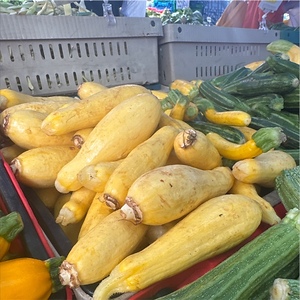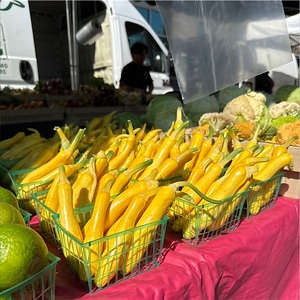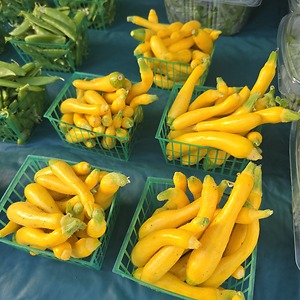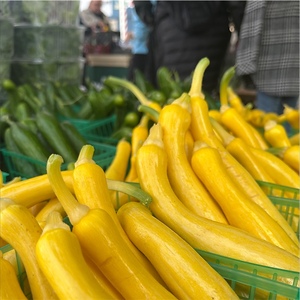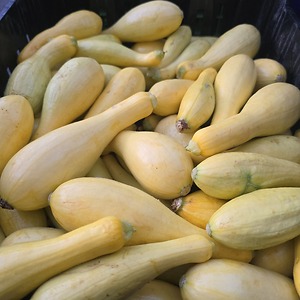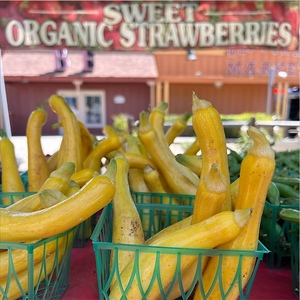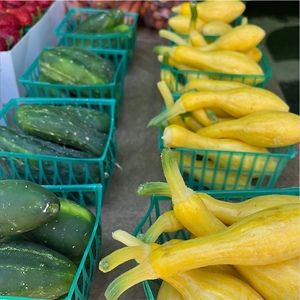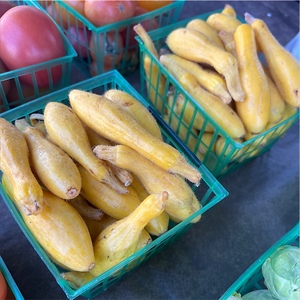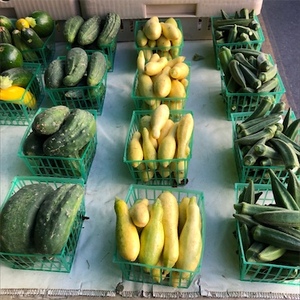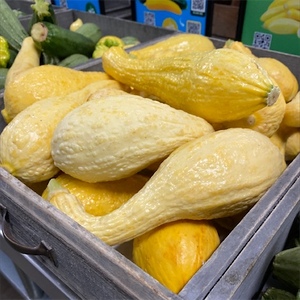


Baby Yellow Crookneck Squash
Estimated Inventory, 10 lbs : 0
Description/Taste
Baby Yellow Crookneck squash are named for their crooked soda bottle shape and miniature size. Harvested early to achieve their small size, these vegetables typically measure 10 to 15 centimeters in length and feature curved necks with bulbous bodies. They have a cornflower yellow hue and thin, delicate skin. Their skin is oftentimes shiny and smooth, though sometimes develops faint ridges and warts on its surface as a result of crossbreeding with neighboring varieties. Baby Yellow Crookneck squash has a pale yellow-white flesh with a tender, watery consistency that’s slightly denser than straight-necked yellow squash. The center of this flesh contains a few edible seeds that are white in tone and soft in texture. The most flavorful part of the Baby Yellow Crookneck squash is the skin, which contrasts with the mild flesh. Overall, the vegetable has a mellow, buttery, and nutty flavor, which can be slightly sweet yet bitter, with a hint of zesty pepper.
Seasons/Availability
Baby Yellow crookneck squash is available year-round with a peak season in the summer months.
Current Facts
Baby Yellow Crookneck squash are botanically classified as Cucurbita pepo and belong to the Cucurbitaceae family of squash, gourds, cucumbers, pumpkins, and melons. This variety is believed to be one of the oldest summer squashes, harvested early while the rind is still edible. Winter squash varieties need to have their rind removed prior to consumption. Rather than growing on vines, Baby Yellow Crooknecks are bush-type squashes that can be picked at various stages of maturity. The longer they are left on the plant, the larger they get. This variety can be left on the vine to mature into full-grown Crookneck squash, allowed to fully mature and harden into an ornamental gourd, or harvested for seeds to plant in the future.
Nutritional Value
Baby Yellow Crookneck squash contains vitamins C and B6, nutrients essential for immune function, skin and respiratory health, collagen production, tissue repair, iron absorption, mood regulation, and converting food into energy. They contain fiber and potassium to help manage digestion, blood sugar and cholesterol levels, fluid balance, nerve function, and muscle contractions. This variety possesses carotenoids such as beta-carotene, lutein, zeaxanthin, and dehydroascorbic acid, elements necessary for protecting the eyes against ultraviolet rays that could lead to chronic eye diseases like macular degeneration.
Applications
Baby Yellow Crookneck squash is tender enough to be eaten fresh but can also be steamed, sautéed, grilled, roasted, or baked. In their raw form, they can be spiralized into squash noodles as an alternative to pasta, cut lengthwise for a vegetable tray, or grated into baked goods like bread, muffins, and brownies. This variety is often drizzled with olive oil and roasted with salt, pepper, thyme, basil, oregano, parsley, sesame, ginger, tarragon, or balsamic vinegar. Baby Yellow Crookneck squash can be sliced into lasagnas, pizza, pasta, frittata, casserole, enchiladas, or ratatouille. This variety may also be halved, hollowed, stuffed, and baked whole or mixed into soups, curries, chowders, omelets, and sauces. They pair well with ingredients like tomatoes, eggplant, onion, garlic, roasted poultry, corn, shelling beans, toasted nuts, and cheeses like goat, parmesan, ricotta, and gorgonzola. Baby Yellow Crookneck squash can be stored in the crisper drawer of a refrigerator for about 10 days or diced and stored in freezer bags for later use.
Ethnic/Cultural Info
Baby Yellow Crookneck squash was first grown by the Abenaki Nation, a group of indigenous people who inhabited the Northeast region of North America. The Abenaki tribes cultivated these “seven sister” crops for centuries: corn, beans, sunflower, tobacco, ground cherry, Jerusalem artichoke, and squash. Growing these crops was crucial for them because it enabled the establishment of more permanent villages, where ideas could be exchanged and intercultural interactions could occur. Today, seed banks of the Abenaki Nation preserve traditional foods like the Baby Yellow Crookneck squash and the stories behind their cultivation.
Geography/History
Baby Yellow Crookneck squash are descendants of the Crookneckneck variety native to the Northeast United States, specifically what is now modern-day New Jersey. Native Americans introduced Crookneck squash to colonial gardeners in the early 1700s. The Yellow Crookedneck variety began to grow in popularity when their seeds were given to Thomas Jefferson in 1807 by a Philadelphia Quaker named Timothy Matlack. According to Jefferson’s garden book, these seeds were found by the Cooper family of Camden who had sewn them for generations. Baby Yellow Crookneck squash are a cultivated variety that’s mostly grown in commercial and home garden settings, picked early to attain their small size. They thrive in full sun, warm weather, and fertile, well-drained soil. During their peak summer seasons, Baby Yellow Crookneck squash may be found at grocery stores and farmers’ markets.
Recipe Ideas
Recipes that include Baby Yellow Crookneck Squash. One
| Chocolate and Zucchini |
|
Yellow Zucchini Tarte Fine on a Yogurt-Based Crust |
| Cookography |
|
Pan-Sauteed Tiny Baby Squash |



